Using Ecological Footprint Analysis to Evaluate Sustainable Development in Lushan County, China
Abstract
:1. Introduction
2. Materials and Methods
2.1. Study Area
2.2. Data
2.3. Methods
2.3.1. Traditional EF Model
2.3.2. EF Calculation
2.3.3. Biocapacity Calculation
2.3.4. Factor Calculation
2.3.5. Sustainable Development Assessment
3. Results
3.1. Per Capita EF Trends
3.2. Per Capita Biocapacity Trends
3.3. ED/ES Dynamics per Capita
3.4. Sustainable Development Assessment in Lushan County
4. Discussion
4.1. Improvements in the EF Method for Mountainous Cities
4.2. Future Trends in EF Development
4.3. Future Sustainability Development Strategies
4.4. Limitations
5. Conclusions
Author Contributions
Funding
Data Availability Statement
Acknowledgments
Conflicts of Interest
References
- Borsdorf, A.; Stötter, J.; Grabherr, G.; Bender, O. Impacts and Risks of Global Change. In Impact of Global Changes on Mountains; CRC Press: Boca Raton, FL, USA, 2014; ISBN 978-0-429-17291-5. [Google Scholar]
- Jansky, L.; Ives, J.D.; Furuyashiki, K.; Watanabe, T. Global Mountain Research for Sustainable Development. Glob. Environ. Chang. 2002, 12, 231–239. [Google Scholar] [CrossRef]
- Badar, R.N.; Bahadure, S.P. Assessing Tourism Sustainability in Hill Towns: Case Study of Shimla, India. J. Mt. Sci. 2020, 17, 2241–2261. [Google Scholar] [CrossRef]
- Qin, Y.; Luo, G.; Li, Y.; Tan, Q.; Zheng, C.; Yu, M.; Liao, J.; Li, M. Assessment of Sustainable Development of Rural Settlements in Mountainous Areas: A Case Study of the Miaoling Mountains in Southwestern China. Land 2022, 11, 1666. [Google Scholar] [CrossRef]
- Yang, M.; Zhao, Y.; Zhao, T. Landscape Evaluation of Rural and Small Towns in Siming Mountain of Zhejiang Based on Landscape Performance. E3S Web Conf. 2020, 143, 01034. [Google Scholar] [CrossRef]
- Borucke, M.; Moore, D.; Cranston, G.; Gracey, K.; Iha, K.; Larson, J.; Lazarus, E.; Morales, J.C.; Wackernagel, M.; Galli, A. Accounting for Demand and Supply of the Biosphere’s Regenerative Capacity: The National Footprint Accounts’ Underlying Methodology and Framework. Ecol. Indic. 2013, 24, 518–533. [Google Scholar] [CrossRef]
- Wackernagel, M.; Rees, W. Our Ecological Footprint: Reducing Human Impact on the Earth; New Society Publishers: Gabriola, BC, Canada, 1998; ISBN 978-0-86571-312-3. [Google Scholar]
- Wackernagel, M.; Monfreda, C.; Schulz, N.B.; Erb, K.-H.; Haberl, H.; Krausmann, F. Calculating National and Global Ecological Footprint Time Series: Resolving Conceptual Challenges. Land. Use Policy 2004, 21, 271–278. [Google Scholar] [CrossRef]
- Solarin, S.A.; Tiwari, A.K.; Bello, M.O. A Multi-Country Convergence Analysis of Ecological Footprint and Its Components. Sustain. Cities Soc. 2019, 46, 101422. [Google Scholar] [CrossRef]
- Hopton, M.E.; White, D. A Simplified Ecological Footprint at a Regional Scale. J. Environ. Manag. 2012, 111, 279–286. [Google Scholar] [CrossRef] [PubMed]
- Ryu, H.C. Modeling the per Capita Ecological Footprint for Dallas County, Texas: Examining Demographic, Environmental Value, Land-Use, and Spatial Influences; Texas A&M University: College Station, TX, USA, 2005. [Google Scholar]
- Caird, S.; Roy, R. Household Ecological Footprints—Demographics and Sustainability. J. Env. Assmt. Pol. Mgmt. 2006, 8, 407–429. [Google Scholar] [CrossRef]
- Verhofstadt, E.; Van Ootegem, L.; Defloor, B.; Bleys, B. Linking Individuals’ Ecological Footprint to Their Subjective Well-Being. Ecol. Econ. 2016, 127, 80–89. [Google Scholar] [CrossRef]
- Gössling, S.; Hansson, C.B.; Hörstmeier, O.; Saggel, S. Ecological Footprint Analysis as a Tool to Assess Tourism Sustainability. Ecol. Econ. 2002, 43, 199–211. [Google Scholar] [CrossRef]
- Gassner, A.; Lederer, J.; Kanitschar, G.; Ossberger, M.; Fellner, J. Extended Ecological Footprint for Different Modes of Urban Public Transport: The Case of Vienna, Austria. Land. Use Policy 2018, 72, 85–99. [Google Scholar] [CrossRef]
- Wang, H.; Huang, J.; Zhou, H.; Deng, C.; Fang, C. Analysis of Sustainable Utilization of Water Resources Based on the Improved Water Resources Ecological Footprint Model: A Case Study of Hubei Province, China. J. Environ. Manag. 2020, 262, 110331. [Google Scholar] [CrossRef] [PubMed]
- Destek, M.A.; Sinha, A. Renewable, Non-Renewable Energy Consumption, Economic Growth, Trade Openness and Ecological Footprint: Evidence from Organisation for Economic Co-Operation and Development Countries. J. Clean. Prod. 2020, 242, 118537. [Google Scholar] [CrossRef]
- Wackernagel, M.; Monfreda, C.; Erb, K.-H.; Haberl, H.; Schulz, N.B. Ecological Footprint Time Series of Austria, the Philippines, and South Korea for 1961–1999: Comparing the Conventional Approach to an ‘Actual Land Area’ Approach. Land Use Policy 2004, 21, 261–269. [Google Scholar] [CrossRef]
- Barrett, J.; Simmons, C. An Ecological Footprint of the UK: Providing a Tool to Measure the Sustainability of Local Authorities; Stockholm Environment Institute: Stockholm, Sweden, 2003. [Google Scholar]
- Wiedmann, T.; Minx, J.; Barrett, J.; Wackernagel, M. Allocating Ecological Footprints to Final Consumption Categories with Input–Output Analysis. Ecol. Econ. 2006, 56, 28–48. [Google Scholar] [CrossRef]
- Jie, H.; Khan, I.; Alharthi, M.; Zafar, M.W.; Saeed, A. Sustainable Energy Policy, Socio-Economic Development, and Ecological Footprint: The Economic Significance of Natural Resources, Population Growth, and Industrial Development. Util. Policy 2023, 81, 101490. [Google Scholar] [CrossRef]
- Niccolucci, V.; Bastianoni, S.; Tiezzi, E.B.P.; Wackernagel, M.; Marchettini, N. How Deep Is the Footprint? A 3D Representation. Ecol. Model. 2009, 220, 2819–2823. [Google Scholar] [CrossRef]
- Ruževičius, J. Ecological Footprint as an Indicator of Sustainable Development. Econ. Manag. 2010, 15, 711–718. [Google Scholar]
- Wei, Z.; Jian, Z.; Sun, Y.; Pan, F.; Han, H.; Liu, Q.; Mei, Y. Ecological Sustainability and High-Quality Development of the Yellow River Delta in China Based on the Improved Ecological Footprint Model. Sci. Rep. 2023, 13, 3821. [Google Scholar] [CrossRef]
- Wiedmann, T.; Barrett, J. A Review of the Ecological Footprint Indicator—Perceptions and Methods. Sustainability 2010, 2, 1645–1693. [Google Scholar] [CrossRef]
- Ding, Y.; Peng, J. Impacts of Urbanization of Mountainous Areas on Resources and Environment: Based on Ecological Footprint Model. Sustainability 2018, 10, 765. [Google Scholar] [CrossRef]
- Yang, Y.; Ling, S.; Zhang, T.; Yao, C. Three-Dimensional Ecological Footprint Assessment for Ecologically Sensitive Areas: A Case Study of the Southern Qin Ling Piedmont in Shaanxi, China. J. Clean. Prod. 2018, 194, 540–553. [Google Scholar] [CrossRef]
- Cole, V. Using Ecological Footprint Analysis to Measure Sustainability in a Himalayan Tourist Centre; University of Manitoba: Winnipeg, MB, Canada, 2000. [Google Scholar]
- An, N.; Zeng, W.; Yang, B. Research on Geo-Ecological Restoration of Mountain Towns Upon the Influence of Earthquake Disasters—A Case Study of 4.20 Lushan Earthquake; Doha, Qatar, 2020. Available online: https://isocarp.org/app/uploads/2021/06/ISOCARP_2020_An_380.pdf (accessed on 28 June 2024).
- Galli, A.; Wiedmann, T.; Ercin, E.; Knoblauch, D.; Ewing, B.; Giljum, S. Integrating Ecological, Carbon and Water Footprint into a “Footprint Family” of Indicators: Definition and Role in Tracking Human Pressure on the Planet. Ecol. Indic. 2012, 16, 100–112. [Google Scholar] [CrossRef]
- Liu, M.; Li, W.; Zahng, D.; Su, N. The Calculation of Equivalence Factor for Ecological Footprints in China: A Methodological Note. Front. Environ. Sci. Eng. 2015, 9, 1015–1024. [Google Scholar] [CrossRef]
- Liu, J.; Raven, P.H. China’s Environmental Challenges and Implications for the World. Crit. Rev. Environ. Sci. Technol. 2010, 40, 823–851. [Google Scholar] [CrossRef]
- Liu, Y.; Li, L. Mountainous City Featured Landscape Planning Based on GIS-AHP Analytical Method. ISPRS Int. J. Geo-Inf. 2020, 9, 211. [Google Scholar] [CrossRef]
- Mikulčić, H.; Wang, X.; Duić, N.; Dewil, R. Environmental Problems Arising from the Sustainable Development of Energy, Water and Environment System. J. Environ. Manag. 2020, 259, 109666. [Google Scholar] [CrossRef] [PubMed]
- Yang, E.; Yao, Q.; Long, B.; An, N.; Liu, Y. Progress in the Research of Features and Characteristics of Mountainous Rural Settlements: Distribution, Issues, and Trends. Sustainability 2024, 16, 4410. [Google Scholar] [CrossRef]
- Wang, Y.; Xiang, P. Urban Sprawl Sustainability of Mountainous Cities in the Context of Climate Change Adaptability Using a Coupled Coordination Model: A Case Study of Chongqing, China. Sustainability 2019, 11, 20. [Google Scholar] [CrossRef]
- Han, C.; Wang, G.; Yang, Y. An Assessment of Sustainable Wellbeing and Coordination of Mountain Areas: A Case Study of Qinba Mountain Area in China. Ecol. Indic. 2023, 154, 110674. [Google Scholar] [CrossRef]
- Lushan County People’s Government 2023 Lushan County Government Work Report. Available online: http://www.yals.gov.cn/gongkai/show/8bef5172c5b40b216fb6cad29080d691.html (accessed on 26 June 2024).
- Lushan County People’s Government Geographical Overview. Available online: http://www.yals.gov.cn/lushan/e49fddb5-8787-4f21-93a6-9896130cff2d.html (accessed on 28 June 2024).
- Lushan County People’s Government Humanities Overview. Available online: http://www.yals.gov.cn/lushan/83cb8992-02eb-4829-9ba5-405fb4e4cfde.html (accessed on 27 June 2024).
- Lushan County People’s Government Economic Overview. Available online: http://www.yals.gov.cn/lushan/e52c550a-7d24-494c-8679-d790281074b2.html (accessed on 27 June 2024).
- Yang, J.; Huang, X. The 30 m Annual Land Cover Dataset and Its Dynamics in China from 1990 to 2019. Earth Syst. Sci. Data 2021, 13, 3907–3925. [Google Scholar] [CrossRef]
- Wackernagel, M.; Yount, J.D. The Ecological Footprint: An Indicator of Progress Toward Regional Sustainability. Env. Monit. Assess. 1998, 51, 511–529. [Google Scholar] [CrossRef]
- Li, R.; Wang, X.; Wang, Q. Does Renewable Energy Reduce Ecological Footprint at the Expense of Economic Growth? An Empirical Analysis of 120 Countries. J. Clean. Prod. 2022, 346, 131207. [Google Scholar] [CrossRef]
- Chuai, X.; Huang, X.; Lu, Q.; Zhang, M.; Zhao, R.; Lu, J. Spatiotemporal Changes of Built-Up Land Expansion and Carbon Emissions Caused by the Chinese Construction Industry. Environ. Sci. Technol. 2015, 49, 13021–13030. [Google Scholar] [CrossRef] [PubMed]
- Hardin, G. Paramount Positions in Ecological Economics. Ecological economics: The Science and Management of Sustainability; Columbia University Press: New York, NY, USA, 1991; pp. 47–57. [Google Scholar]
- Rees, W.; Wackernagel, M. Urban Ecological Footprints: Why Cities Cannot Be Sustainable—And Why They Are a Key to Sustainability. In Urban Ecology; Marzluff, J.M., Shulenberger, E., Endlicher, W., Alberti, M., Bradley, G., Ryan, C., Simon, U., ZumBrunnen, C., Eds.; Springer: Boston, MA, USA, 2008; pp. 537–555. ISBN 978-0-387-73411-8. [Google Scholar]
- Senbel, M.; McDaniels, T.; Dowlatabadi, H. The Ecological Footprint: A Non-Monetary Metric of Human Consumption Applied to North America. Glob. Environ. Chang. 2003, 13, 83–100. [Google Scholar] [CrossRef]
- Viviroli, D.; Archer, D.R.; Buytaert, W.; Fowler, H.J.; Greenwood, G.B.; Hamlet, A.F.; Huang, Y.; Koboltschnig, G.; Litaor, M.I.; López-Moreno, J.I.; et al. Climate Change and Mountain Water Resources: Overview and Recommendations for Research, Management and Policy. Hydrol. Earth Syst. Sci. 2011, 15, 471–504. [Google Scholar] [CrossRef]
- Westveer, J.; Freeman, R.; McRae, L.; Marconi, V.; Almond, R.E.A.; Grooten, M. A Deep Dive into the Living Planet Index: A Technical Report; WWF: Gland, Switzerland, 2022. [Google Scholar]
- Chuai, X.; Gao, R.; Huang, X.; Lu, Q.; Zhao, R. The Embodied Flow of Built-up Land in China’s Interregional Trade and Its Implications for Regional Carbon Balance. Ecol. Econ. 2021, 184, 106993. [Google Scholar] [CrossRef]
- Nie, W.; Shi, Y.; Siaw, M.J.; Yang, F.; Wu, R.; Wu, X.; Zheng, X.; Bao, Z. Constructing and Optimizing Ecological Network at County and Town Scale: The Case of Anji County, China. Ecol. Indic. 2021, 132, 108294. [Google Scholar] [CrossRef]
- Li, Y.; Guo, T.T.; Li, P.P. Evaluation Analysis of Ecological Footprint Model. Appl. Mech. Mater. 2011, 99–100, 487–490. [Google Scholar] [CrossRef]
- Liu, C.; Cutforth, H.; Chai, Q.; Gan, Y. Farming Tactics to Reduce the Carbon Footprint of Crop Cultivation in Semiarid Areas. A Review. Agron. Sustain. Dev. 2016, 36, 69. [Google Scholar] [CrossRef]
- Ya’an Daily Client Lushan: Green Development and Ecological Economy Go Hand in Hand. Available online: https://wap.beiww.com/zsya/xw/jd/202304/t20230412_1153661.html (accessed on 28 June 2024).
- Ya’an Municipal Ecological Environment Bureau Lushan County Explores How to Use the “Green Content” of the Ecological Environment to Enhance the “Gold Content” of Economic Development. Available online: https://sthjj.yaan.gov.cn/xinwen/show/1d787865e7f0be93049d7b713b4b59ef.html (accessed on 28 June 2024).
- Sichuan Provincial Government Gazette Decision on Naming the Second Batch of Provincial-Level Ecological Counties. Available online: https://www.sc.gov.cn/10462/11555/11562/2023/1/9/da1781f1bfbe49ed81c9ad19873ec0a9.shtml (accessed on 28 June 2024).
- Martire, S.; Castellani, V.; Sala, S. Carrying Capacity Assessment of Forest Resources: Enhancing Environmental Sustainability in Energy Production at Local Scale. Resour. Conserv. Recycl. 2015, 94, 11–20. [Google Scholar] [CrossRef]
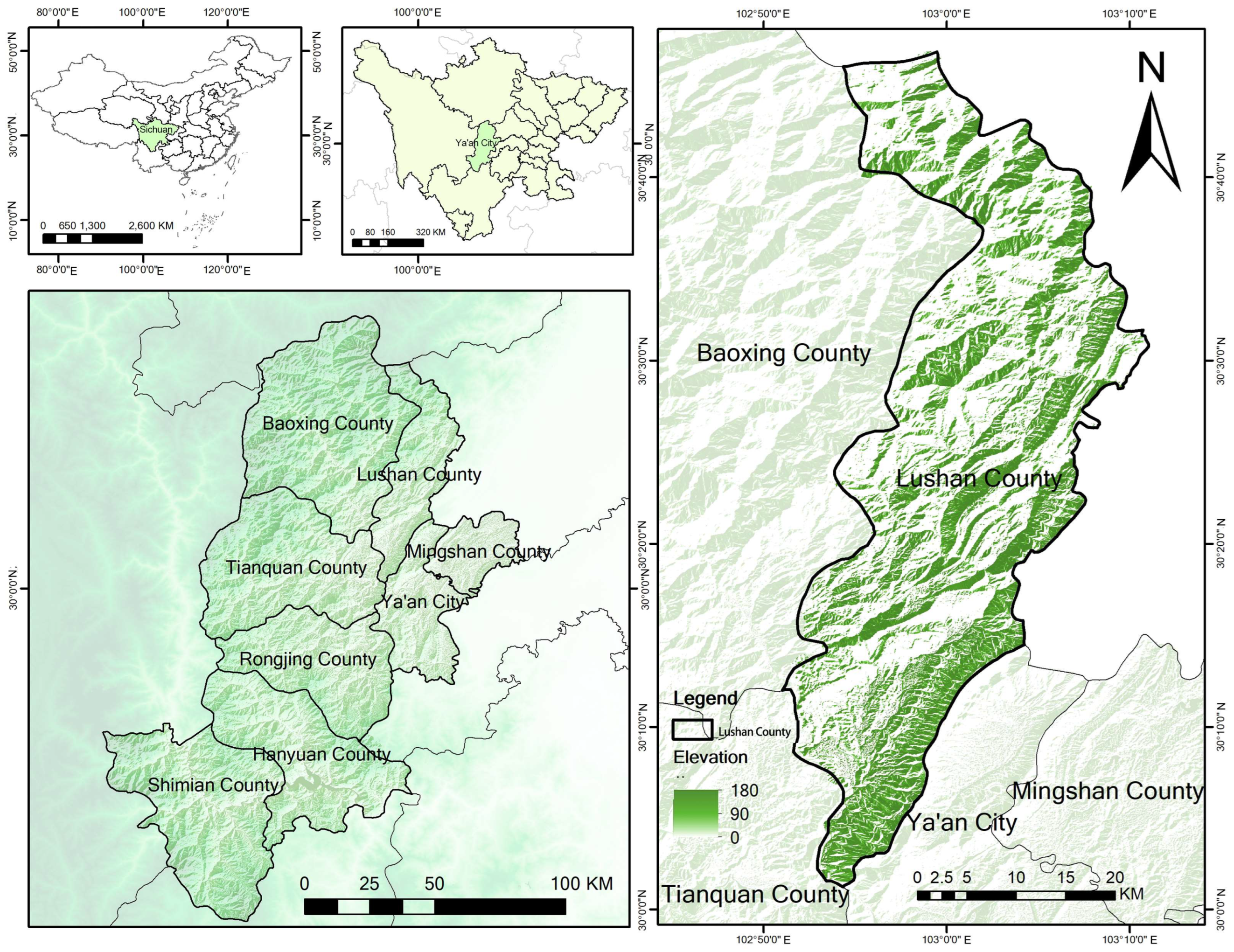
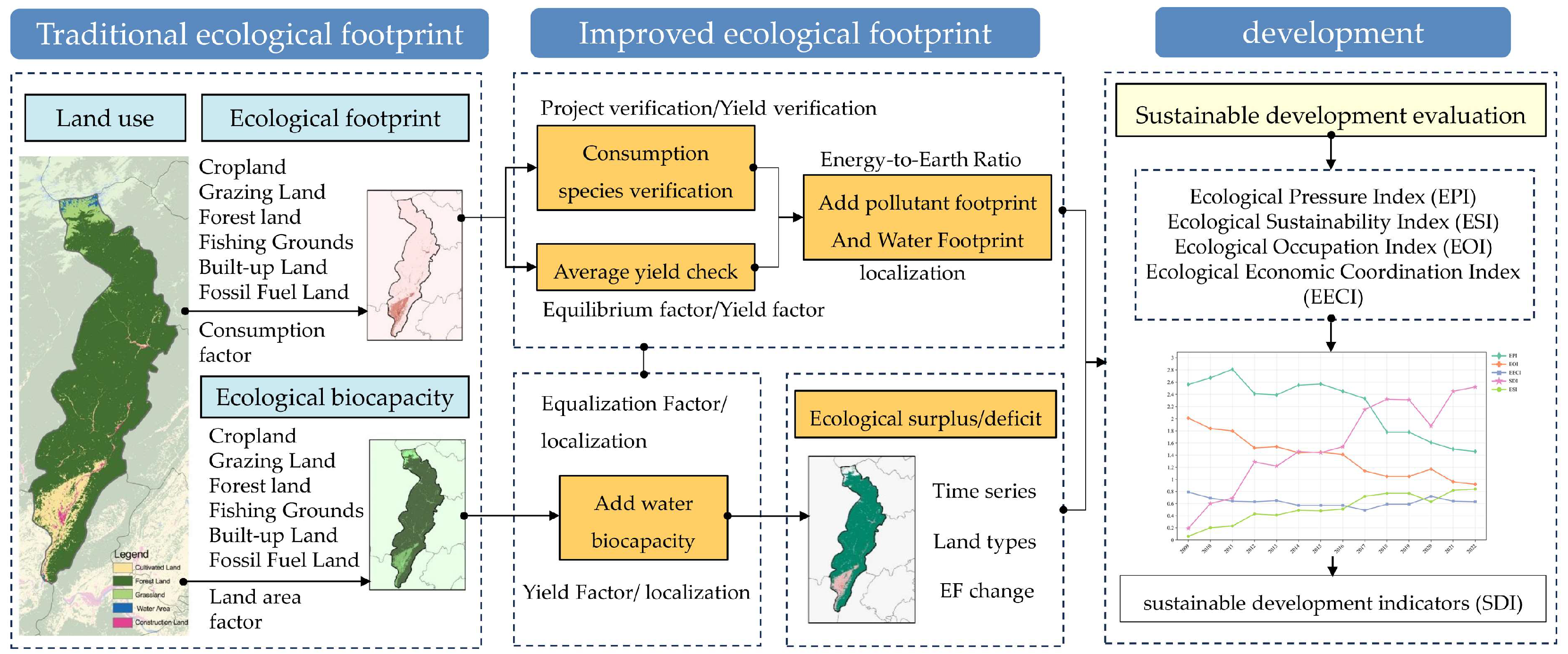
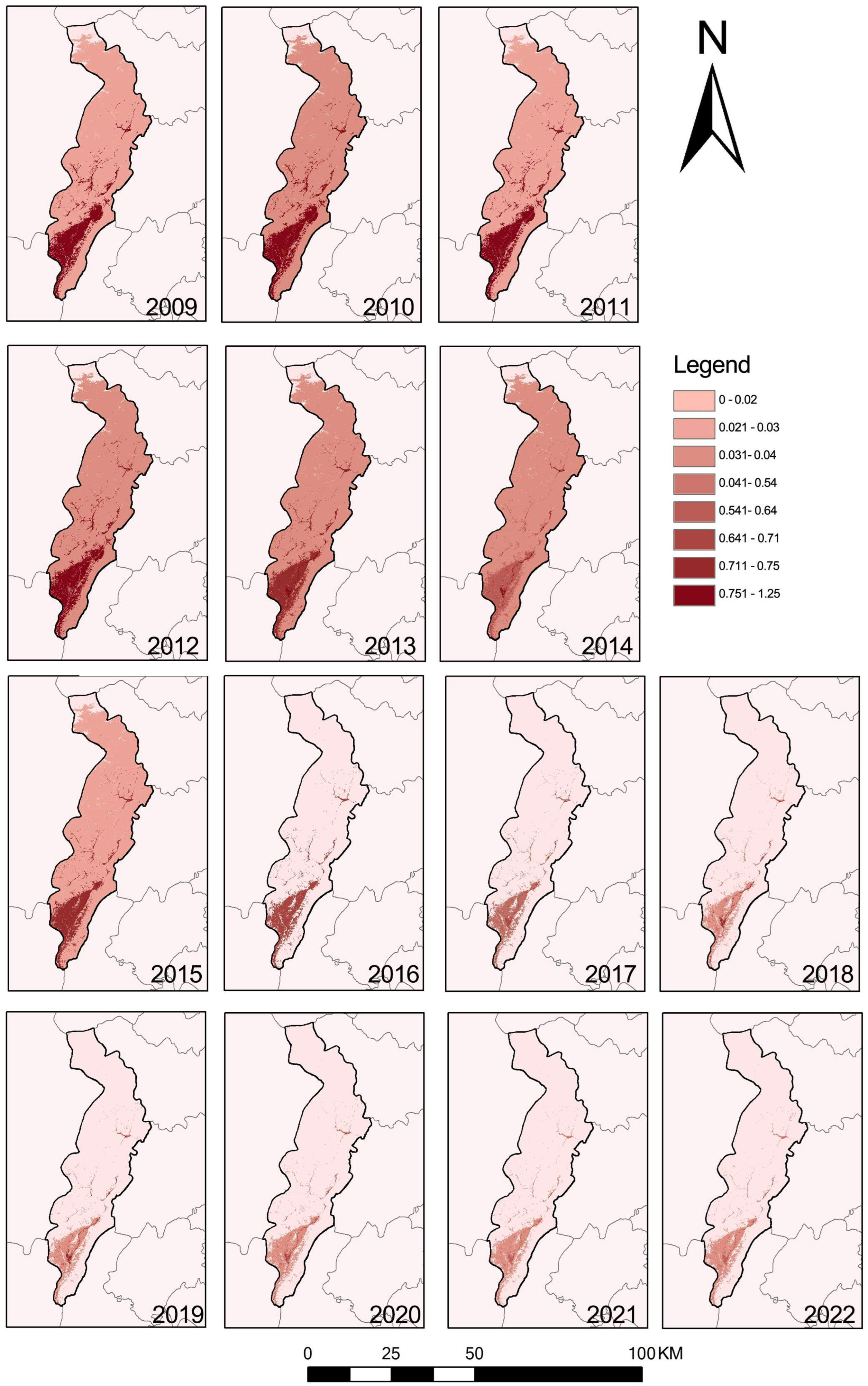
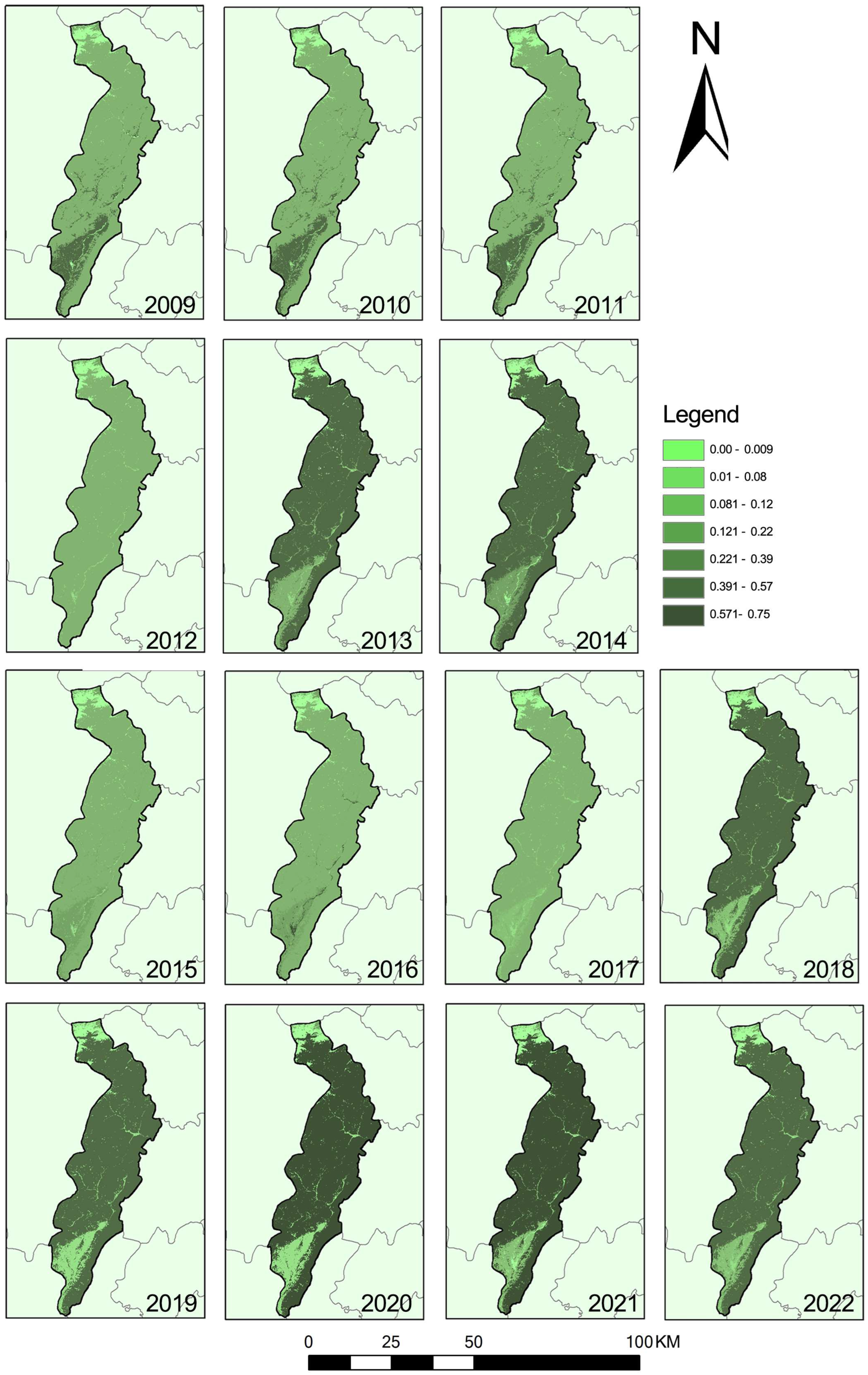

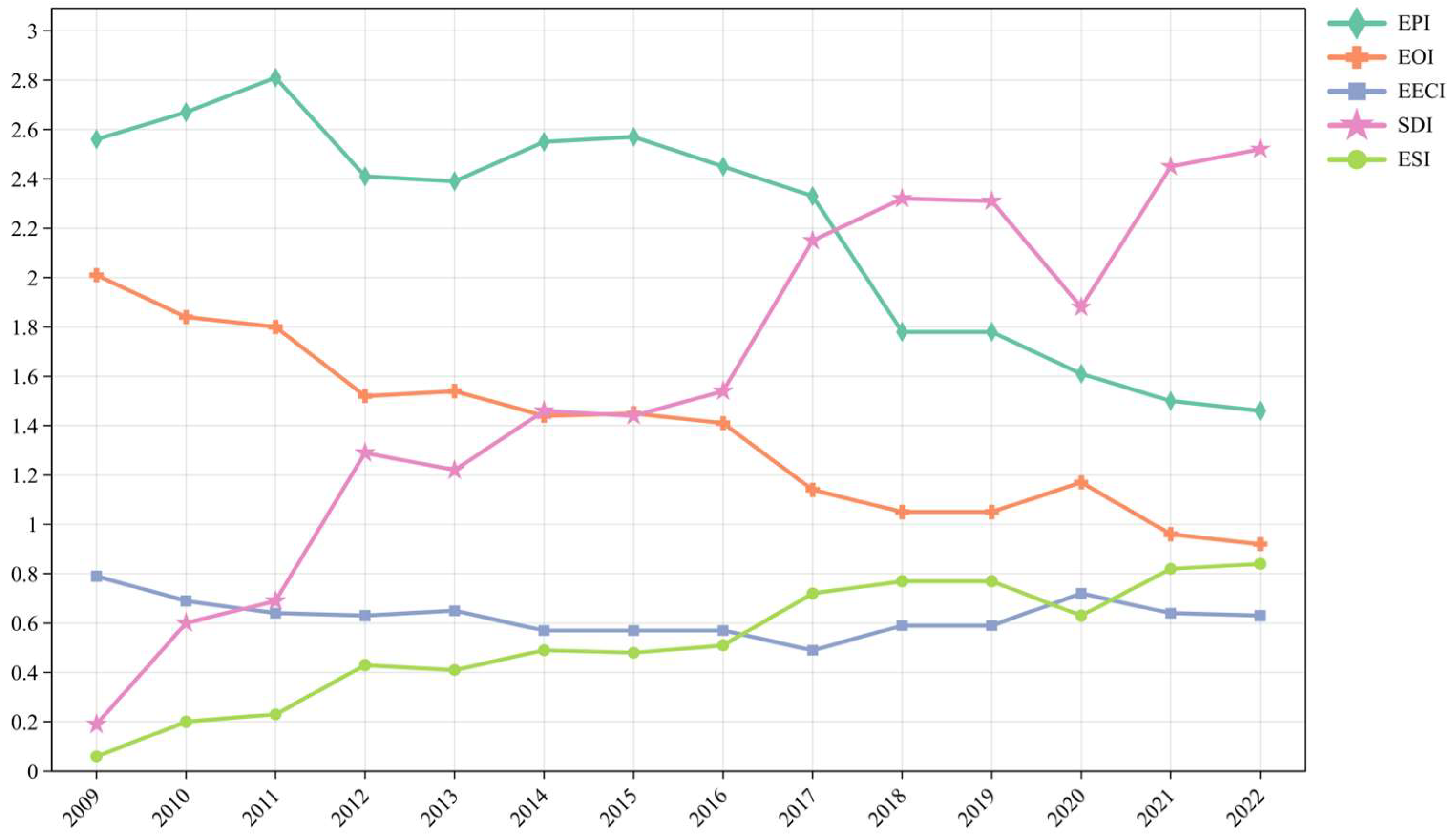
| Data | Source |
|---|---|
| National Average Yield | “China Agricultural Yearbook”, “Compilation of National Agricultural Product Cost-Benefit Data”, “China Fisheries Yearbook”, “China Forestry Yearbook”, “China Statistical Yearbook” |
| Biological Products in Lushan County | “Ya’an Statistical Yearbook” from 2009 to 2022, “Lushan County Statistical Yearbook” from 2009 to 2022 |
| Energy Types in Lushan County | “Ya’an Statistical Yearbook” from 2009 to 2022, “Statistical Bulletin of National Economic and Social Development of Lushan County”, on-site data collected by Lushan County Economic and Technological Bureau |
| Pollutants in Lushan County | “Ya’an Statistical Yearbook” from 2009 to 2022, on-site data collected by Lushan County Environmental Protection Bureau |
| Land Area in Lushan County | “Ya’an Statistical Yearbook” from 2009 to 2022, “Annual Statistical Report on Urban (County) Construction in Sichuan Province” from 2009 to 2022, remote sensing image interpretation of Lushan County from 2009 to 2022 |
| Land Type | Definition |
|---|---|
| Cropland | The land is used for growing various crops and providing primary food and plant products for humans. |
| Grazing land | Land is mainly used for grazing livestock, such as cattle and sheep, providing meat and other animal products for humans. |
| Forest land | Refers to natural or artificial forests that provide various products for human production and living, including timber, bamboo, nuts, etc. |
| Built-up land | The land is occupied by various engineering facilities and residential activities, including land used for hydropower generation. Most built-up land is converted from cropland [43,45]. |
| Fossil fuel land | Refers to the area required to absorb the CO2 produced from the combustion of fossil fuels, indicating the land’s carbon sequestration capacity. In EF calculations, forests generally have the highest CO2 sequestration capacity [43]. |
| Fishing ground | The space required for fishing. |
| Indicator | Level | Criteria |
|---|---|---|
| EPI | Extremely Unsafe | >2.00 |
| Very Unsafe | 2.00–1.51 | |
| Somewhat Unsafe | 1.50–1.01 | |
| Slightly Unsafe | 1.00–0.81 | |
| Somewhat Safe | 0.80–0.51 | |
| Very Safe | <0.50 | |
| ESI | Highly Unsustainable | <0.2 |
| Moderately Unsustainable | 0.2–0.35 | |
| Weakly Unsustainable | 0.35–0.5 | |
| Weakly Sustainable | 0.5–0.65 | |
| Moderately Sustainable | 0.65–0.8 | |
| Highly Sustainable | >0.8 | |
| EOI | Very Poor | <0.5 |
| Poor | 0.51–1.00 | |
| Somewhat Wealthy | 1.01–2.00 | |
| Wealthy | 2.01–3.00 | |
| Very Wealthy | 3.01–4.00 | |
| Extremely Wealthy | >4.00 | |
| EECI | Very Poor Coordination | <1.00 |
| Poor Coordination | 1.01–2.00 | |
| Fair Coordination | 2.01–3.00 | |
| Good Coordination | 3.01–4.00 | |
| Very Good Coordination | 4.01–8.00 | |
| Excellent Coordination | >8.00 | |
| SDI | Very Poor Sustainability | <0.63 |
| Poor Sustainability | 0.63–0.89 | |
| Fair Sustainability | 0.90–1.30 | |
| Good Sustainability | 1.31–1.62 | |
| Very Good Sustainability | 1.63–2.11 | |
| Excellent Sustainability | >2.11 |
| EPI | EOI | EECI | SDI | ESI | |
|---|---|---|---|---|---|
| 2009 | Extremely Unsafe | Wealthy | Very Poor Coordination | Very Poor Sustainability | Moderately Unsustainable |
| 2010 | Extremely Unsafe | Somewhat Wealthy | Very Poor Coordination | Very Poor Sustainability | Moderately Unsustainable |
| 2011 | Extremely Unsafe | Somewhat Wealthy | Very Poor Coordination | Very Poor Sustainability | Moderately Unsustainable |
| 2012 | Extremely Unsafe | Somewhat Wealthy | Very Poor Coordination | Very Poor Sustainability | Moderately Unsustainable |
| 2013 | Extremely Unsafe | Somewhat Wealthy | Very Poor Coordination | Very Poor Sustainability | Moderately Unsustainable |
| 2014 | Extremely Unsafe | Somewhat Wealthy | Very Poor Coordination | Very Poor Sustainability | Moderately Unsustainable |
| 2015 | Extremely Unsafe | Somewhat Wealthy | Very Poor Coordination | Very Poor Sustainability | Moderately Unsustainable |
| 2016 | Extremely Unsafe | Somewhat Wealthy | Very Poor Coordination | Very Poor Sustainability | Moderately Unsustainable |
| 2017 | Extremely Unsafe | Somewhat Wealthy | Very Poor Coordination | Poor Sustainability | Moderately Unsustainable |
| 2018 | Very Unsafe | Somewhat Wealthy | Very Poor Coordination | Poor Sustainability | Highly Unsustainable |
| 2019 | Very Unsafe | Somewhat Wealthy | Very Poor Coordination | Poor Sustainability | Highly Unsustainable |
| 2020 | Very Unsafe | Somewhat Wealthy | Very Poor Coordination | Poor Sustainability | Highly Unsustainable |
| 2021 | Very Unsafe | Somewhat Wealthy | Very Poor Coordination | Poor Sustainability | Highly Unsustainable |
| 2022 | Very Unsafe | Somewhat Wealthy | Very Poor Coordination | Poor Sustainability | Highly Unsustainable |
Disclaimer/Publisher’s Note: The statements, opinions and data contained in all publications are solely those of the individual author(s) and contributor(s) and not of MDPI and/or the editor(s). MDPI and/or the editor(s) disclaim responsibility for any injury to people or property resulting from any ideas, methods, instructions or products referred to in the content. |
© 2024 by the authors. Licensee MDPI, Basel, Switzerland. This article is an open access article distributed under the terms and conditions of the Creative Commons Attribution (CC BY) license (https://creativecommons.org/licenses/by/4.0/).
Share and Cite
Yang, H.; Yan, S.; An, N.; Yao, Q. Using Ecological Footprint Analysis to Evaluate Sustainable Development in Lushan County, China. Land 2024, 13, 1081. https://doi.org/10.3390/land13071081
Yang H, Yan S, An N, Yao Q. Using Ecological Footprint Analysis to Evaluate Sustainable Development in Lushan County, China. Land. 2024; 13(7):1081. https://doi.org/10.3390/land13071081
Chicago/Turabian StyleYang, Huihui, Shuiyu Yan, Na An, and Qiang Yao. 2024. "Using Ecological Footprint Analysis to Evaluate Sustainable Development in Lushan County, China" Land 13, no. 7: 1081. https://doi.org/10.3390/land13071081
APA StyleYang, H., Yan, S., An, N., & Yao, Q. (2024). Using Ecological Footprint Analysis to Evaluate Sustainable Development in Lushan County, China. Land, 13(7), 1081. https://doi.org/10.3390/land13071081








